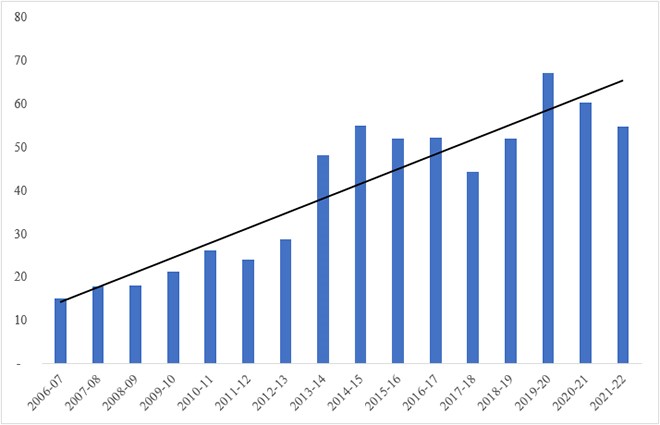-
CENTRES
Progammes & Centres
Location
Measuring the development impacts of India’s overseas programmes is important as it can help improve its ability to deliver on the ground and maximise the value for money

India’s development partnership programme is as old as its independent history. The Indian government announced 70 scholarships for students from developing countries in Asia and Africa shortly after its independence in 1949 and its flagship programme, the Indian Technical and Economic Cooperation (ITEC) Programme was launched in 1964. The country also has a long-standing tradition of challenging the conventional discourse on international development. As a newly independent country with high rates of poverty and underdevelopment, India understood the challenges faced by other Asian and African countries emerging from the yoke of colonialism and sought to share its own development experience with other developing countries in the spirit of anti-colonialism and third-world solidarity. The normative principles of India’s development cooperation in the early years were of great significance because the international aid architecture was dominated by the West and Western aid often made developing countries more dependent on the West. Despite its significance, India’s development cooperation programme garnered less attention globally because India itself was a large aid recipient until the early 1990s.
The normative principles of India’s development cooperation in the early years were of great significance because the international aid architecture was dominated by the West and Western aid often made developing countries more dependent on the West.
Things have changed fundamentally since then. India’s development cooperation programme grew rapidly from the 2000s on the back of strong economic growth and rising aspirations as a global leader. As shown in the figure, India’s technical and economic cooperation budget grew at a compound annual growth rate of 9 percent from INR 15.1 billion in 2006-7 to INR 54.7 billion in 2021-22. India launched the India Development Initiative (later renamed as India Development and Economic Assistance Scheme) in 2003 to support development projects like roads and railways in other developing countries. So far, India has extended concessional lines of credit to support infrastructure projects worth US$ 34.4 billion to developing countries in Asia, Africa, and Latin America. According to scholars like Rani Mullen, in purchasing power terms, India’s development cooperation budget is larger than several OECD countries like Canada, Australia, South Korea, and Austria. In other words, India’s development cooperation programme is now comparable to the foreign assistance programmes of several high-income countries.
Figure 1: India’s Technical and Economic Cooperation Budget from 2006-07 60 2021-22 (in INR Billions at constant 2011 prices)
 Source: Chakrabarty (2022)
Source: Chakrabarty (2022)
Note: Wholesale Price Indicator deflator has been used to convert the budget estimates to constant 2011-12 prices.
Two features of India’s development cooperation programme stand out prominently. First, the principle of mutual benefit and demand-driven development. India’s development cooperation programme is not in line with the OECD’s donor-recipient model. Unlike the OECD-DAC countries, India calls itself a “development partner” and its aim is mutual benefit. India also emphasises demand-driven development rather than a donor-prescribed programme as it wants to align its development cooperation programme with its partner’s priorities. Second, is its ability to provide low-cost development solutions to the developing world. Consultancy fees and administrative costs (sometimes as high as 10 percent) account for a high proportion of Western aid. Several experts like Kishore Mahbubani argue that a large part of Western aid is recycled back to the Western countries. However, unlike its Western counterparts, India’s administrative expenses are much lower and the country does not hire expensive consultants for its projects. Therefore, it is able to implement its projects and training programmes at a fraction of the cost incurred by the developed countries.
Recently, India’s External Affairs Minister, Dr S. Jaishankar, said that the Global South sees India as a credible and effective development partner with strong delivery on the ground. While India’s development cooperation programme has, indeed, grown substantially in the last two decades and several features of its development partnership programme make it stand out, there are scant studies on the impacts of India’s development programmes overseas. Mutual benefit is a stated objective of India’s development cooperation programme, but we do not have clear answers to questions like: Has India’s development cooperation benefited partner countries? To what extent? What is the actual impact of India’s development cooperation on economic growth, efficiency, and human development in partner countries?
India also emphasises demand-driven development rather than a donor-prescribed programme as it wants to align its development cooperation programme with its partner’s priorities. Second, is its ability to provide low-cost development solutions to the developing world.
The Indian government has not made adequate efforts to assess the actual impact of India’s development spending overseas. India has successfully challenged the Western discourse on development cooperation. Now it needs to ensure that its development projects overseas make real impacts on the lives of people. Official reports on the development impacts of Indian development initiatives abroad are lacking and little information is available for systematic study. There are no systematic studies in the public domain on the impacts of Indian capacity-building initiatives like ITEC, which have been operational for nearly 60 years. Similarly, while India has extended concessional finance worth US$ 34.4 billion for infrastructure development in developing countries, there are limited studies on the development impacts of the lines of credit programme. Research on India’s development cooperation is at a nascent stage in India as only a few scholars and institutions are researching India’s development partnerships. The country needs to invest resources in measuring the impacts of its operations in other countries. Measuring the development impacts of its overseas programmes will improve its ability to deliver on the ground, identify strengths and weaknesses in its initiatives, and maximise the value for money. Without developing its own capacity to assess development effectiveness, India runs the risk of being judged by Western scholars and institutions alone, which are increasingly conducting survey-based studies on India’s development projects abroad.
Malancha Chakrabarty is Senior Fellow and Deputy Director (Research) at the Observer Research Foundation
The views expressed above belong to the author(s). ORF research and analyses now available on Telegram! Click here to access our curated content — blogs, longforms and interviews.

Dr Malancha Chakrabarty is Senior Fellow and Deputy Director (Research) at the Observer Research Foundation where she coordinates the research centre Centre for New Economic ...
Read More +